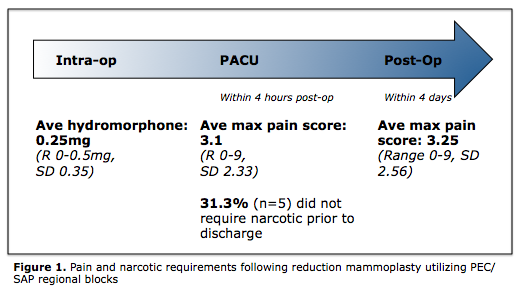PEC Blocks and Pain: Analysis of the Breast Reduction Population Amidst the Opioid Crisis
Bao Tram Nghiem, MD1, Alap U. Patel1, Rachel E. Stahl2, Sonia Pyne2, Danielle M. Lindenmuth2, Ashley N. Amalfi1.
1University of Rochester, Rochester, NY, USA, 2University of Rochester Medical Center, Rochester, NY, USA.
BACKGROUND: According to the CDC, deaths in the United States from prescription opioid overdoses have been rising since 1999. Surgeons in particular have been cited as contributors to the high number of unused pills by overprescribing, fueling the nontherapeutic use of these medications. There are currently no guidelines on managing post-operative pain in reduction mammoplasty patients amidst the opioid crisis. We describe a single-surgeon experience utilizing pre-operative regional nerve blocks and a narcotic-sparing protocol with excellent pain control following reduction mammoplasty.
METHODS: Retrospective review of 16 patients undergoing outpatient reduction mammoplasty with regional nerve blocks. All patients received pectoralis (PEC1) ± PEC2 and serratus (SAP) blocks prior to induction. Postoperatively, patients received 10 tablets of oxycodone 5mg and a recommended 7-day pain regiment of gabapentin, acetaminophen, and ibuprofen. Pain was assessed via intraoperative, PACU, and home narcotic requirements and pain scores.
RESULTS: Pertinent medical history included chronic pain (6.25%), anxiety (43.8%), and depression (37.5%). The average hydromorphone given intraoperatively was 0.25mg (range 0-0.5mg; SD 0.35). In PACU, the average maximum pain score was 3.1 (range 0-9; SD 2.33) on a 0-10 scale and 31.3% did not require narcotics prior to discharge. Within the first 4 days, patients reported maximum pain of 3.25 (range 0-9; SD 2.56); block started to resolve after 26.2 hours (range 9-55; SD 13.4); and block completely resolved after 34.3 hours (range 16-70; SD 13.4). There were no block-related complications and 93.8% would proceed with block again. Patients took an average of 2.45 tablets of oxycodone (range 0-5), none required a refill. Gabapentin was used for an average of 3.36 days (range 0-7) and >80% did not require any analgesics beyond 7 days.
CONCLUSION: PEC/SAP blocks can safely reduce immediate postoperative pain, with average maximum pain scores of only 3.1 and 3.25 within 4 hours and 4 days, respectively. Low pain scores may be attributed to the duration of block. Opioids were being overprescribed, as patients required an average of less than 3 tablets of oxycodone. PEC/SAP blocks in combination with non-opioids are a powerful, low-risk, well-tolerated means of post-operative pain control. This information can encourage non-opioid alternatives and strictly limit the number of narcotics prescribed. 
Back to 2019 Posters
